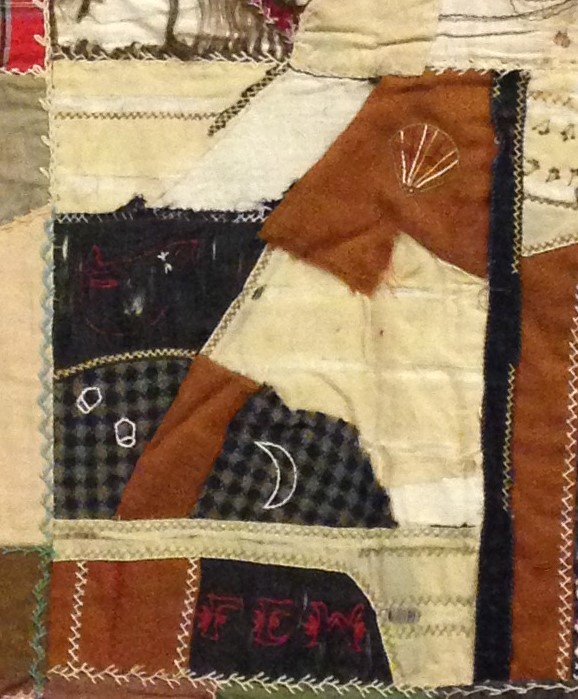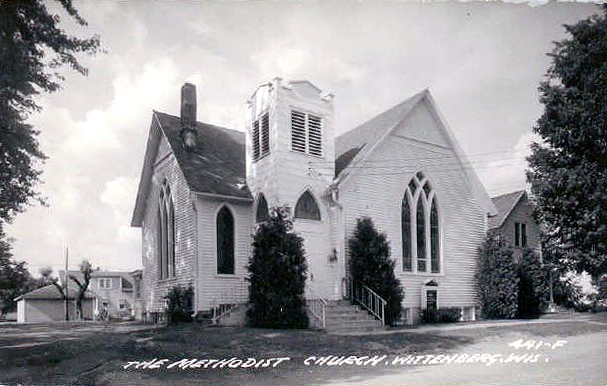Crazy Quilt
Crazy Quilt - 1915
Crazy quilts were popular from the late 1800s through the early 1900s. They featured irregular shaped pieces of fabric sewn to a foundation fabric and then outlined with embroidery stitches. The most elaborate crazy quilts were made of silk satins and velvets and heavily embroidered with images of flowers and animals. More practical versions were made of cotton or wool, with a limited amount of embroidery.

This quilt was made as a group project by the ladies of the Methodist Church in Wittenberg around 1915. It includes a wide variety of fabrics. Each woman probably made a block or two and she used what she had on hand. Some ladies were skilled in needlework and embellished their blocks with fancy embroidery stitches. Others embroidered images in outline stitch, as in the block with the cat and moon. A few did only basic embroidery stitches around the fabric shapes. One block contains the names of people involved in the making of this quilt.
Note that some of the fabrics are worn through and only the backing remains. This can be an indication of hard use but it is probably also a result of the practice of “silk weighting”. When silks were manufactured, metallic salts were added and absorbed by the fibers. This gave them a heavier, more expensive feel (and allowed the merchant to charge more). In time the salts caused the fibers to break down.
There is no batting in this quilt, which is common for crazy quilts; the foundation fabric takes the place of a filler. A brown plaid fabric was used as the backing and wrapped around to the front to form the edging. Large hand quilting stitches follow the edges of each block and are covered by embroidery.

Gronlund Family Quilt
In 1915, at the age of 12, Matilda “Mickey” Gronlund and her family lost their home in Gralapp Mills (near Wittenberg, Wisconsin) and everything they owned to a fire. For the rest of her life, Mickey had vivid memories of walking in the cold in her bare feet to find a warm house to stay in.
In response to the loss, a group of women from the Methodist Church in Wittenberg held a shower for Mickey’s mother to help the family recover. This crazy quilt had already been made by the group for a different church project but it was instead donated to the Gronlund family.
Little is known about Mickey’s family, except that they lived in Gralapp Mills at the time of the fire. This small town south of Wittenberg was settled by Henry Gralapp, who owned a large sawmill operation. It’s likely Mickey’s father worked at the mill and moved to Merrill, Wisconsin, shortly after the devastating fire. Mickey was employed at the Merrill Candy company for 23 years and died in 2001.
Gralapp Mills
The town of Gralapp Mills was founded in 1881 when Henry Gralapp purchased land adjacent to the Embarrass River south of Wittenberg, Wisconsin. With his brother, William, he erected a sawmill and planing mill, of which he became sole owner in 1893. At the height of production for his mill, Henry was recognized as one of the leading lumber dealers in east-central Wisconsin. As often happened with small towns settled around a logging operation, Gralapp Mills was eventually abandoned, although the land remained in the Gralapp family for several decades.
In 1885, Henry married Mary Rakow of Marathon County and they had two children, Ella and Walter. The family belonged to the Methodist Episcopal Church in Wittenberg, which Henry helped to build. It was this church that donated the quilt to the Gronlund family after the fire that destroyed their home and possessions. The names of Mary, Henry, Ella, and Walter all appear on the quilt.
